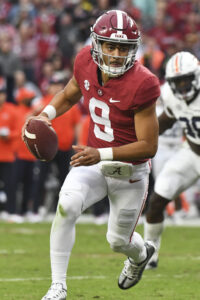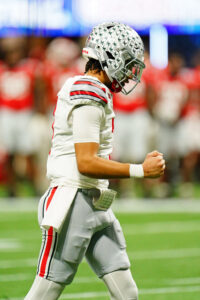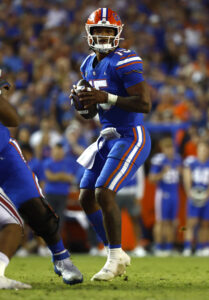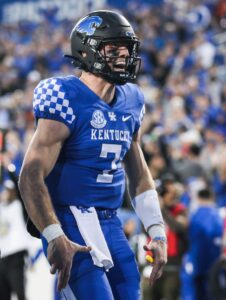After last year’s draft, which saw only one quarterback taken in the first two rounds, this year’s draft class boasts a bit more top talent at the NFL’s signature position. The group’s superior personnel has already created a small amount of chaos atop the draft order with Carolina trading into the No. 1 overall pick. With three of the teams drafting at the top of the first round expected to have a need for a new quarterback, and several others having the option to trade up for one, there is a consensus that four quarterbacks should hear their names called on the night of April 27.
Teams interested in a new passer will have their choice between whoever is left of Alabama’s Bryce Young, Ohio State’s C.J. Stroud, Florida’s Anthony Richardson, and Kentucky’s Will Levis. Below, we’ll explore the benefits offered by each young quarterback and provide some reasoning as to why they may or may not hear their names called first.
Bryce Young
Not only was Young the best recruit in his state or at his position coming out of high school, the young athlete out of Mater Dei (California) was rated as the nation’s No. 1 overall recruit in 2020, according to 247sports.com. He committed to nearby USC with two years left of high school play but flipped his commitment to Alabama at the beginning of his senior year. 
Young played sparingly as a freshman in Tuscaloosa, backing up junior starter Mac Jones. With Jones having departed for the NFL, Young took over the Crimson Tide offense as a sophomore. He took the college football world by storm in 2021, completing 66.91% of his passes for 4,872 yards and 47 touchdowns while only throwing seven interceptions. He took Alabama to the title game, falling to Georgia but stoking early perceptions of himself as a future No. 1 overall draft pick. In 2022, Young continued to impress despite the loss of several top receivers, two to the first two rounds of the previous year’s draft. He completed 64.47% of his passes for 3,328 yards, 32 touchdowns, and five interceptions.
Young came into college as the nation’s top dual-threat passer but never developed as much of a rusher at Alabama. Instead, he utilized his versatility to be an effective passer on the run. Young’s eyes and mind work fast through progressions and help him to anticipate throwing lanes at an elite level. He’s adapted to his smaller size in terms of vision, but he requires his lower body to make strong throws. Teams don’t seem to worry about his lack of size as much as his durability. In a league that’s already seen success from a smaller quarterback in Kyler Murray, Young is expected to become a starting quarterback at the NFL level before long.
C.J. Stroud
 Not far from Young in the southern California area, Stroud came out of the same class out of Rancho Cucamonga (California). Not quite as touted as Young, Stroud still boasted five stars as the nation’s second-best pro-style quarterback, according to 247. He made his decision late in the process but enrolled early shortly after committing to Ohio State.
Not far from Young in the southern California area, Stroud came out of the same class out of Rancho Cucamonga (California). Not quite as touted as Young, Stroud still boasted five stars as the nation’s second-best pro-style quarterback, according to 247. He made his decision late in the process but enrolled early shortly after committing to Ohio State.
Stroud also sat his true freshman season, redshirting behind starter Justin Fields. He was easily as productive as Young in their first years starting. In 2021, Stroud completed 71.88% of his passes for 4,435 yards and 44 touchdowns while only tossing six interceptions. Last year, Stroud, too, saw a bit of a drop-off in production, losing two receivers in the first round, but still impressed while completing 66.32% of his passes for 3,688 yards, 41 touchdowns, and six interceptions.
Stroud seems to be the most prototypical of the four options. His size, strength, and athleticism all signify a routine pro quarterback. His size gives him an ideally strong platform from which to throw and allows him to layer balls into short and intermediate levels over lineman and backers. The size does limit his agility, making him slow out of breaks and inaccurate when throwing on the run. His biggest strength, though, is his pure passing ability. He throws a strong, tight ball in a smooth motion, resulting in passes that receivers love to catch. His traditional quarterback makeup could be what makes him so attractive to a team like the Panthers at No. 1.
Anthony Richardson
Richardson is far and away the wild card of this group. A consensus four-star, dual-threat quarterback out of Eastside (Florida), Richardson stayed home in Gainesville for college after some back-and-forth on his commitment to the Gators. 
Richardson is the least experienced of the four top options at quarterback. Richardson redshirted behind Kyle Trask as a freshman and sat behind Emory Jones as a sophomore. It wasn’t until last year that Richardson found himself starting behind center. Unlike the unquestionable success of Young and Stroud, Richardson’s results were hardly as impressive. Last season, Richardson completed 53.82% of his passes for 2,529 yards and 17 touchdowns while throwing nine interceptions. He did display a stronger rushing ability than the above two, racking up 654 yards on 103 rushing attempts and tacking on nine scores with his legs. As a starter for the Gators, Richardson ended college with a 6-7 record.
Despite the seemingly mediocre production, Richardson has skyrocketed up draft boards as pundits have fallen in love with his potential. Richardson has a large frame, similar to Stroud, but boasts an athleticism that makes it much more dangerous. His size and burst make him reminiscent of a young Cam Newton with the ball in his hands. Richardson has a rocket for an arm, completing easy throws with only a flick of the wrist. The physical frame and abilities are there in a raw form, but much molding is necessary. He’s extremely inconsistent in his decision-making and accuracy, resulting in dangerous passes into a crowd and misses that never stand a chance of hitting their targets.
This is a common high-risk, high-reward situation with drafting quarterbacks. Richardson could develop into an All-Pro or flame out, unable to make the most of his abilities.
Will Levis
 Levis is another curious prospect whose production doesn’t quite match his hype as a top draft pick. A three-star prospect leaving Xavier (Connecticut), Levis committed to Penn State as part of the 2018 recruiting class. After redshirting as a freshman, Levis sat for two years behind Sean Clifford before transferring to Kentucky.
Levis is another curious prospect whose production doesn’t quite match his hype as a top draft pick. A three-star prospect leaving Xavier (Connecticut), Levis committed to Penn State as part of the 2018 recruiting class. After redshirting as a freshman, Levis sat for two years behind Sean Clifford before transferring to Kentucky.
Levis took over as an immediate starter in Lexington and won 10 games for the Wildcats in 2021, completing 66.01% of his passes for 2,826 yards and 24 touchdowns while tossing 13 interceptions. Levis also displayed an ability to run the ball that year, producing 376 yards and nine touchdowns. When Wan’Dale Robinson and Josh Ali departed for the NFL, Levis’s production suffered as a result. In 2022, injuries and the loss of his top targets led to a down year in which he completed 65.37% of his passes for 2,406 yards, 19 touchdowns, and 10 interceptions, all without displaying the rushing ability of prior years.
Like Richardson, Levis boasts the size, arm strength, and athleticism that make him an extremely attractive prospect on paper. There are latent abilities available within Levis, but a lack of sound technique and procedure hold Levis back from his full potential. He can throw strong balls through tight windows but also struggles with consistent accuracy. He is physical and tough but needs that toughness when standing too long in the pocket. There are strong tools to utilize at the NFL level, but it will likely take time and a good coach preaching strong technique in order for Levis to become a strong starter at the next level. Teams want him to be the next Josh Allen, but he has a way to go in order to get there.
There we have it: two strong options who seem ready to start in Week 1 and two developmental projects who could turn into stars in the right system. Which team needs which quarterback the most? Tell us in the comments who you’d want your team to take a chance on.
Stroud going 1 or I’m surprised.
also Hendon Hooker might be the best of the batch
I was thinking a lot about Hendon Hooker lately. I do think that Levis may be a better prospect in terms of talent and potential, but if I had to bet I would say Hooker is most likely to have a successful career outside Stroud and Young. He won’t be drafted high and forced to play early like Richardson or Levis. His injury will ensure that he has to develop his first year before he gets playing time. If I was the fan of a team that needed to draft a QB and my team didn’t have a top 2 pick I would want them to either tank for next year or get a late first to draft Hooker.
will be interesting to see where he ends up
He’s probably a first round pick if not for the injury & his age. Second round steal!
Young isn’t a 10 year QB. He’s a QB who will struggle to play 12-14 games a year.
Raider fan and big Hooker fan (insert LV joke).
My comparison for him would Jalen Hurts from two years ago. Can run some, can pass some, and doesn’t make a lot of mistakes. Stroud looks pretty solid, but I don’t know that Hooker is any worse than the other three.
also Hendon Hooker may be best of the batch
But can the Steelers use him?
no Kenny better than all these boys
Way too early make a reach like that.
If Kenny was at Alabama they easily win Natty.
i wanna read about the best of the rest. seen plenty about these dudes already.
Ask any Florida fan about Richardson and you get a completely different picture. They think he is another Trey Lance, i.e., a china doll when it comes to injuries, too little game experience, etc. The 49ers would gladly get rid of Lance if somebody were foolish enough to offer up a pick, and this guy is probably going to end up the same way – especially if he ends up on a bad team that has no offensive head coach/focus.
I wouldnt draft Young. He’s too small. They used Murray as a reason he can succeed?! Yikes. I must have missed when Murray succeeded in the NFL, outside of being handed an absurd contract that his franchise undoubtably regrets.
These fragile or smaller QB’s like Kyler Murray, Tua Tagualiova, Colt McCoy, Taylor Heinicke, Lamar Jackson mostly seem to struggle to stay on the field. If a team is going to go small/fragile at the QB position, they better make their main investment offensive line.
I think Young goes first. This article talks about his eyes and mind anticipating throwing opportunities at an elite level. True, but just as important, his eyes and mind also let him feel pressure in the pocket and to adjust quickly at an elite level. That’s a significant difference between him and the other QBs mentioned here and team evaluators know this.
Stroud to the Texans. Rather see him d/t Young’s injury potential. I’d take Young if they were both the same size.